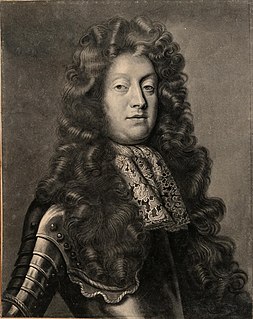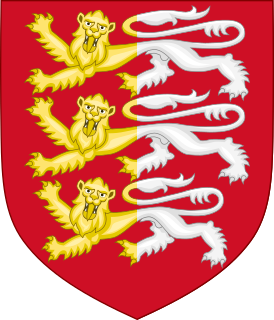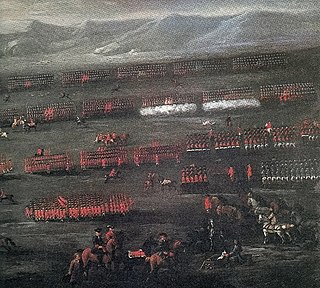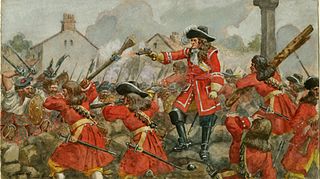Related Research Articles

Jacobitism was a largely 17th- and 18th-century movement that supported the restoration of the senior line of the House of Stuart to the British throne. The name is derived from Jacobus, the Latin version of James.

The Battle of the Boyne was a battle in 1690 between the forces of the deposed King James II of England and Ireland, VII of Scotland, and those of King William III who, with his wife Queen Mary II, had acceded to the Crowns of England and Scotland in 1689. The battle took place across the River Boyne close to the town of Drogheda in the Kingdom of Ireland, modern-day Republic of Ireland, and resulted in a victory for William. This turned the tide in James's failed attempt to regain the British crown and ultimately aided in ensuring the continued Protestant ascendancy in Ireland.

Mary of Modena was Queen of England, Scotland, and Ireland as the second wife of James II and VII (1633–1701). A devout Roman Catholic, Mary married the widower James, who was then the younger brother and heir presumptive of Charles II (1630–1685). She was uninterested in politics and devoted to James and their children, two of whom survived to adulthood: the Jacobite claimant to the thrones, James Francis Edward, and Louisa Maria Teresa.

Charles Middleton, 2nd Earl of Middleton, Jacobite 1st Earl of Monmouth, PC was a Scottish and English politician who held several offices under Charles II and James II & VII. He served as Secretary of State for Scotland, the Northern Department and the Southern Department, before acting as Jacobite Secretary of State and chief advisor to James II and then his son James III during their exile in France.

The Treaty of Limerick, signed on 3 October 1691, ended the 1689 to 1691 Williamite War in Ireland, a conflict related to the 1688 to 1697 Nine Years' War. It consisted of two separate agreements, one with military terms of surrender, signed by commanders of a French expeditionary force and Irish Jacobites loyal to the exiled James II. Baron de Ginkell, leader of government forces in Ireland, signed on behalf of William III and his wife Mary II. It allowed Jacobite units to be transported to France, the diaspora known as the Flight of the Wild Geese.

The Williamite War in Ireland, was a conflict between Jacobite supporters of deposed monarch James II and Williamite supporters of his successor, William III. It is also called the Jacobite War in Ireland, Williamite Conquest of Ireland, or the Williamite–Jacobite War in Ireland.

Richard Talbot, 1st Earl of Tyrconnell PC was an Irish politician, courtier and soldier.

The Nonjuring schism refers to a split in the established churches of England, Scotland and Ireland, following the deposition and exile of James II and VII in the 1688 Glorious Revolution. As a condition of office, clergy were required to swear allegiance to the ruling monarch; for various reasons, some refused to take the oath to his successors William III and II and Mary II. These individuals were referred to as Non-juring, from the Latin verb iūrō, or jūrō, meaning "to swear an oath".

William Herbert, 1st Marquess of Powis, PC was an English nobleman, best remembered for his suffering during the Popish Plot.

John Drummond, 1st Earl of Melfort, styled Duke of Melfort in the Jacobite peerage, was a Scottish politician and close advisor to James II. A Catholic convert, Melfort and his brother the Earl of Perth consistently urged James not to compromise with his opponents, contributing to his increasing isolation and ultimate deposition in the 1688 Glorious Revolution.

Richard Graham, 1st Viscount Preston PC was an English diplomat and politician who sat in the House of Commons in two periods between 1675 and 1689. He became a Jacobite conspirator, but his reputation in the Jacobite community suffered when he gave evidence against his co-conspirators in exchange for a pardon.

Daniel O'Brien, 3rd Viscount Clare was an Irish Jacobite politician and soldier.

The Jacobite rising of 1715 was the attempt by James Edward Stuart to regain the thrones of England, Ireland and Scotland for the exiled Stuarts.
Sir Stephen Rice (1637–1715) was Chief Baron of the Exchequer in Ireland and a notable supporter of James II.
Sir William Ellis was an English Jacobite, secretary of State to James II in exile.
Eleanor Oglethorpe (1684–1775), later Marquise de Mézières, was an English Jacobite who settled in France after James II was deposed in the Glorious Revolution of 1688. She served as an agent and advisor to James III "The Old Pretender" after the death of his father in 1701. Eleanor married in 1707 Eugène Marie de Béthisy, Marquis de Mézières, with whom she had seven children; their descendants include members of royal families throughout Europe.

Honora Burke, married Patrick Sarsfield and went into French exile where he followed her soon afterwards. After his death at the Battle of Landen, she married James FitzJames, 1st Duke of Berwick, an illegitimate son of James II. She may have introduced the country dance to the French court.
The Declaration of Finglas was issued on 17 July 1690 by William III of Ireland at Finglas in County Dublin, shortly after his Williamite army's decisive victory at the Battle of the Boyne during the War of the Two Kings.

The Jacobite rising of 1689 was a revolt seeking to restore James VII, following his deposition in November 1688. Adherents of the exiled House of Stuart were known as 'Jacobites', from Jacobus, Latin for James, and the associated political movement as Jacobitism.
Dominic Sheldon, often written as Dominick Sheldon, was an English soldier. A leading Jacobite he served in James II's Irish Army during the Williamite War between 1689 and 1691. He was a noted cavalry commander, present at the Battle of the Boyne and Battle of Aughrim. Later after going into exile, he rose to the rank of lieutenant general in the French Army. He was also remained a prominent courtier at the Jacobite court in exile at Saint Germain.
References
- Old Bailey Proceedings Online, Trial of John Ashton, Edmund Elliot, Richard Graham . (t16910115-29, 15 January 1691).
Attribution![]() This article incorporates text from a publication now in the public domain : Stephen, Leslie, ed. (1885). "Ashton, John". Dictionary of National Biography . Vol. 2. London: Smith, Elder & Co.
This article incorporates text from a publication now in the public domain : Stephen, Leslie, ed. (1885). "Ashton, John". Dictionary of National Biography . Vol. 2. London: Smith, Elder & Co.